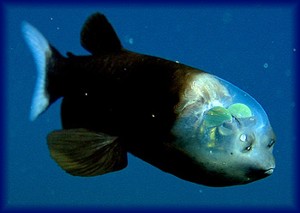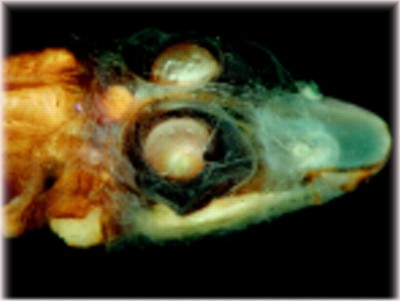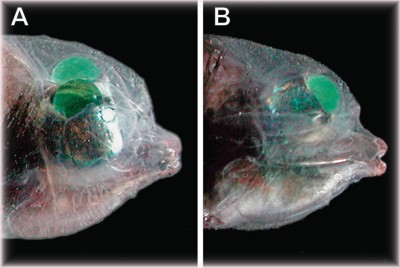|
The eyes have it
Another day, another brilliant window provided into the endless genius of the Creator's mind. The August edition of National Geographic magazine arrived a few days ago. My eyes almost fell out of my head when, while leafing through its pages (doesn't everybody do that first?), an eye-catching picture of a fish with vivid green goggle-eyes embedded in a transparent head caught my attention. Sure, I've seen glass catfish - even owned a few - but this finny fellow sports one of the most intriguing craniums you are ever likely to see. Take a look at the pics above. What at first glance look like eyes are in fact the "nostrils" of Macropinna microstoma, aka the Pacific barreleye fish. The eyes are the greenish, upward-directed hemispheres. Although known since 1939 from netted and beach-stranded specimens, the presence of its bizarre translucent head capsule was unknown until three living specimens were videoed between about 2000 and 2500 feet (615-770 meters) by a deep-sea remotely operated vehicle (ROV) in 2004.
Macropinna is one of a number of deep-sea fish that have upward-directed, pigmented, tubular eyes. The upward orientation obviously enables these fish to see certain things overhead: others of their own kind (for mating purposes), potential predators, or, most importantly, food. Three key features of such eyes - the large crystalline lens at the top, the cylindrical tube supporting the lens, and pigments in the lens - determine what their owners are able to see in the extreme gloom deep down. The large lens and supporting cylindrical pillars are designed to maximize light-gathering capacity while the pigments filter out "unhelpful" wavelengths, as summarized by Schwab:
These lenses would filter out at least a portion of the downwelling light especially on the shorter end of the wavelength spectrum and act as a transmission filter removing wavelengths shorter than perhaps 450 or 460 nm. This would increase acuity by decreasing chromatic aberration, limiting short wavelength light scatter within the eye, and probably by increasing contrast sensitivity by eliminating the "blue haze." (British Journal of Ophthalmology 2001 85: 1148)
|
Schwab then proceeds to explain that the combination of mechanical structure and chemical pigmentation is perfectly designed (my words, not his) to enable the fish to see any overhead organisms that produce bioluminescent light at frequencies and intensities that would render them invisible to eyes such as ours. If you were to go down into the depths in a see-through submersible and look up, you would not see the light-emitting crustaceans and "jellyfish" suspended above you, not even in silhouette. But Macropinna and similarly-endowed fish can! Why would Macropinna want to see such krill and jellies? It eats them. Well, that's what scientists believe based on the anatomy of the alimentary canal. They speculate that Macropinna eats sinking dead crustaceans (such as krill), crustaceans captured in the stinging tentacles of certain jellyfish, and the tentacles themselves.
Mystery surrounded the question of how Macropinna was able to actually catch its prey until the video footage, combined with observation of two living specimens, disclosed the secret. The video clearly showed how the fish would suddenly change its orientation into an upright position and swim upwards to snatch something seen from below. But how could it see its prey once it had changed its orientation? The eyes would be pointed in the wrong direction. Enter stage left a nifty trick. As Fig. 2 shows, when Macropinna changes its bodily orientation it also swivels its eyes so that instead of looking straight up they stare straight ahead. With eyes cocked in this forward orientation Macropinna can home in on its prey. Bye-bye krill or tentacle.
And here is where the transparent fluid in the head capsule comes into play. Imagine it; if you could pivot your eyes so that they looked straight up, you would have a problem, wouldn't you? Your brain and skull would block your view. Now if your skull and brain were totally transparent, the problem would be solved. Macropinna's transparent head capsule solves the problem. Isn't it amazing what millions of years of evolution can do?!
|







